Overview of Earthquakes
Adapted by Sean W. Lacey & Joyce M. McBeth (2018) University of Saskatchewan from Deline B, Harris R, & Tefend K. (2015) “Laboratory Manual for Introductory Geology”. First Edition. Chapter 13 “Earthquakes” by Randa Harris, CC BY-SA 4.0. View Source. Last edited: 8 Jan 2020
9.2 THE EPICENTER, FOCUS, AND WAVES
An earthquake is a like a telegram from the Earth. It sends a message about conditions beneath the Earth’s surface. The shaking or trembling experienced during an earthquake is the result of a rapid release of energy within the Earth, usually as a result of movement along geologic faults (weak planes in the Earth’s crust). In the chapter on geologic structures, we introduced you to faults. In a strike-slip fault like the San Andreas fault in California, USA, rocks on either side of the fault slide past each other. As they move in opposite directions, the rocks become deformed, bend slightly, and build up pressure. Eventually they will reach a breaking point. Once the strength of the rock has been exceeded, the rocks will snap back to their normal shape, releasing the stored energy as an earthquake. The more energy that has been stored, the larger the earthquake. In the chapter on geologic structures we also introduced you to a diagram illustrating the relationship between stress and strain. When rocks are under too great of a stress, the strength of the rock is exceeded, and the rocks undergo brittle failure (the earthquake).
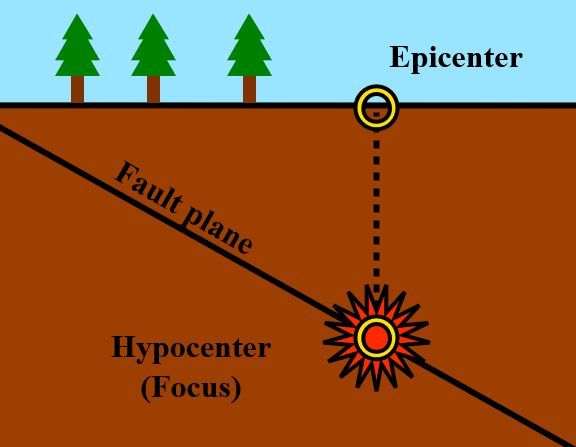
Source: Wikimedia user Sam Hocevar (2014) CC BY-SA 1.0 view source
Earthquakes originate at a point called the focus (plural foci). From this point, energy travels outward in different types of waves. The place on the Earth’s surface directly above the focus is called the epicenter (Figure 9.2). Earthquake foci may be shallow (less than 70 km from Earth’s surface) to deep (greater than 300 km deep), though shallow to intermediate depths are much more common. Earthquakes are more frequent along active tectonic plate boundaries (95 % of all earthquakes occur along plate boundaries), and their depth is related to the type of plate boundary. Shallow focus earthquakes tending to occur at divergent and transform plate boundaries. Convergent plate boundaries have a range of earthquake depths, with the earthquakes moving from shallow to intermediate to deep focus as the subducting plate moves deeper under the overriding plate. The earthquakes associated with convergent boundaries occur along the Wadati-Benioff zone (or Benioff zone) an area of dipping seismicity along the subducting plate (Figure 9.3).
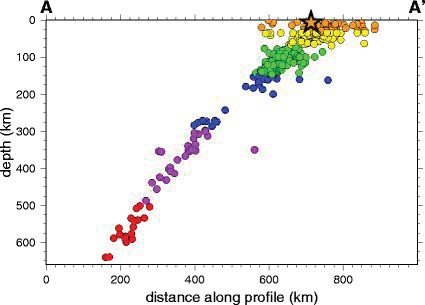
Source: USGS (2006) public domain view source
As an earthquake occurs, two different types of waves are produced; body waves, so termed because they travel through the body of the Earth, and surface waves that travel along the Earth’s surface (Figure 9.4). There are two types of body waves. P-waves, or primary waves, are compressional waves that move back and forth, similar to the action of an accordion or a slinky. As the P waves pass through the Earth’s crust, the rock is compressed and stretched. Movement is compressional parallel to the direction of wave propagation, and because of this P-waves the fastest of the seismic waves. In other words, if you are standing some distance away from the source of an earthquake, the P waves will reach you before the other kinds of seismic waves produced by the earthquake. The P waves can travel through solids, liquids, and gases, because all materials can be compressed to some degree. S-waves, or secondary waves, are shear waves that move material in a direction perpendicular to the direction of travel. S-waves can only travel through solids, and are slower than P-waves. A similar motion to S-wave motion can be created by two people holding a rope, with one snapping the rope quickly. Alternately, you can also think of this wave movement similar to the wave created by fans in a stadium that stand up and sit down. Body waves are responsible for the jolting and motions felt during an earthquake.
Surface waves are slower than body waves. If you are in an earthquake, the surface waves will be more like being in a boat on the sea, a rolling sensation. Because surface waves are located at the ground’s surface where humans (and their structures) are located, and because they move so slowly, which bunches them up and increases their amplitude, they can do a great deal of damage. Love waves are the faster surface waves, and they move material back and forth in a horizontal plane that is perpendicular to the direction of wave travel (see Figure 9.4). Buildings do not handle this type of movement well, and Love waves can also be responsible for considerable damage to structures. Rayleigh waves make the Earth’s surface move in an elliptical motion, similar to the movement in a sea wave. This results in ground movement that is up and down and side-to-side.
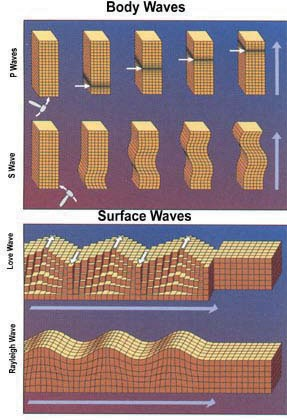
Source: USGS (2004) public domain view source
9.3 SEISMOLOGY
Humans have experienced earthquakes as long as we have existed as a species. Many cultures developed legends to explain them, including envisioning large creatures within the Earth that were moving to create the earthquake. The study of earthquakes, called seismology, began to take off with the development of instruments that can detect earthquakes. A seismograph is an instrument used to measure vibrations moving through the Earth (Figure 9.5). A typical seismograph consists of a mass suspended on a string from a frame that moves as the Earth’s surface moves. A rotating drum is attached to the frame, and a pen attached to the mass, so that the relative motion is recorded in a seismogram. It is the frame (attached to the ground) that moves during an earthquake. The suspended mass generally stays still due to inertia (the tendency of a body to stay at rest and resist movement).

Source: Yamaguchi CC BY-SA 3.0 view source
9.3.1 How Are Earthquakes Measured?
The consequences of earthquakes can be quantified in death tolls and damage to structures, and also in terms of the force and amount of ground shaking. These types of measurements are divided into two types of measurements. Qualitative measures of the damage inflicted by an earthquake (measures that depend upon factors such as the local geology and population density) are referred to as intensity measures. Quantitative measures of the energy released by an earthquake are termed magnitude measures. Both measures provide meaningful data for interpreting the relative importance of an earthquake.
9.3.2 Earthquake Intensity
Intensity measurements take into account both the damage incurred due to the earth quake and the way that people respond to it. The Modified Mercalli Intensity Scale (Figure 9.6) is the most widely used scale to measure earthquake intensities. This scale has values that range from Roman numerals I to XII which characterize the damage observed and people’s reactions to it. Data for this scale is often collected right after an earthquake by having the local population answer questions about the damage they see and what happened during the quake. This information can then be pooled to create an intensity map, which creates colored zones based on the information collected (Figure 9.7). These maps are frequently used by the insurance industry, since the relative amount of damage experienced by infrastructure in a region is included in the characteristics used in the scale.
If you ever experience an earthquake, you can report your experience on the USGS “Did you feel it?” website. Your data will be added to that submitted by other people, and once there is enough data the USGS will plot the Modified Mercalli Intensities across the region affected by the earthquake.
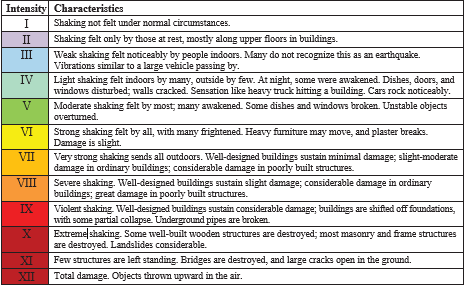
Source: Randa Harris (2015) CC BY-SA 3.0 view source

Source: USGS (2013) Public Domain view source
9.3.3 Earthquake Magnitude
Another way to classify an earthquake is by the amount of energy released during the earthquake event; this is referred to as the magnitude of the earthquake. Magnitude has been measured using the Richter scale in the past. News media still often report earthquake magnitudes “on the Richter scale” but these numbers are actually magnitudes on a new scale that is more commonly used for describing earthquake magnitudes. As the frequency of earthquake measurements around the world increased, it was realized that the Richter magnitude scale was not valid for all earthquakes, because it is not accurate for large magnitude earthquakes. The new scale is called the Moment Magnitude scale. The Moment Magnitude scale is very similar to the Richter scale, and for small earthquakes the numbers are virtually identical. In contrast with the Richter scale, the Moment Magnitude scale estimates the total energy released by an earthquake and can be used to describe the magnitude of any size of earthquake including very large earthquakes. The magnitude is based on the seismic moment (estimated based on ground motions recorded on a seismogram), which is a product of the distance a fault moved and the force required to move it. The abbreviation used to indicate that an earthquake magnitude is on the moment magnitude scale is M or Mw (e.g., a magnitude 4 earthquake is an M 4 or Mw 4 earthquake).
Both the Richter and Moment Magnitude scales are logarithmic scales, which means for each whole number that you increase on the scale the energy released increases by a factor of 10. Each unit on the Moment Magnitude scale represents an increase in energy release of 101.5 (about 32 times the energy). So a magnitude 3 earthquake has 32 times the energy release of a magnitude 2 earthquake. A magnitude 4 earthquake releases 103 or 1000 times as much energy as a magnitude 2 earthquake.
Why is it necessary to have more than one type of scale? The magnitude scale allows for worldwide characterization and comparison of any earthquake event, while the intensity scale does not. With an intensity scale, a IV in one location could be ranked a II or III in another location, based off of building construction (e.g., poorly constructed buildings will suffer more damage in the same magnitude earthquake as those built with stronger construction). Figure 9.8 shows a rough comparison of magnitude scale to intensity.
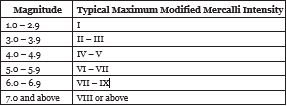
Source: Randa Harris (2015) CC BY-SA 3.0 view source
9.4 LOCATING AN EARTHQUAKE EPICENTER
During an earthquake, seismic waves travel all over the globe. Though they may weaken with distance, seismographs are sensitive enough to still detect these waves. The seismogram data from seismographs can give us information including the distance between the earthquake and the seismograph station. Figure 9.9 shows an example of a seismogram from a station where a small earthquake has occurred, and Figure 9.10 shows a set of seismograms from a station recording a single earthquake event.

Source: USGS Public Domain View source
Seismologists use characteristics of the wave recorded on the seismogram to calculate the times when the P- and S-waves arrived at the seismograph station. This data can be used to calculate the distance from a seismograph station to the earthquake epicentre. Let’s walk through the process of identifying P- and S-wave arrival times at a seismograph station using the seismograms in Figure 9.10. First, identify the positions of the P- and S-wave arrivals, reading from left to right on the seismogram. The arrival of seismic waves will be recognized by an increase in amplitude – look for a pattern change as lines get taller and more closely spaced. By The P-wave arrival is easy to identify, it is the first point where the amplitude of the line (also known as the trace) on the seismogram moves above the flat line. Read the arrival time (usually in seconds) for the P-wave on the x-axis beneath the point where the P-wave arrive (note that there aren’t numbers on the x-axis of Figure 9.10 so for the purposes of this example let’s call the timepoint “0”). The S-wave arrival is a bit trickier to identify, here, it is an increase in the amplitude of the trace that occurs after the P-wave amplitudes start to decrease. All three traces in Figure 9.10 are from the same seismograph station. Note that the arrival times of the P- and S-waves are virtually identical for all three traces but there are some differences in the wave amplitudes depending on the direction of shaking recorded in the trace.
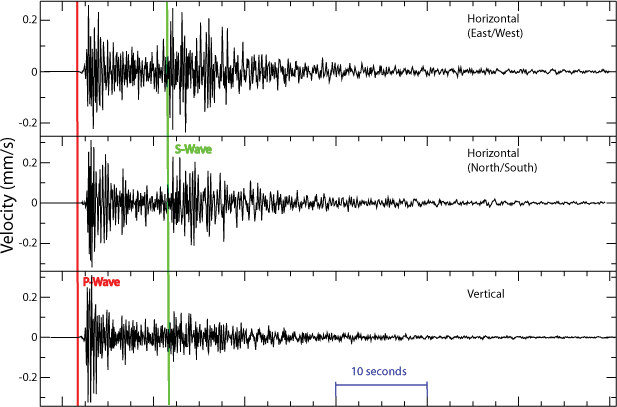
The next step of determining how far the earthquake occurred from the seismograph is to calculate the time interval between the arrival of the P-wave and the arrival of the S-wave. In the example in Figure 9.10, the time between the P- and S-wave arrival times is about 10 s. We can then use a travel-time curve, which is a graph of P- and S-wave arrival times, to determine the distance of the earthquake from the seismograph station (see Figure 9.11). In the example from Figure 9.10, if the P-S arrival difference is 10 s, the earthquake occurred approximately 100 km from the seismograph. A longer time interval between the P- and S-wave indicates the earthquake is a longer distance from the station.
Though distance to the earthquake epicentre can be determined using a travel-time graph, this single seismogram cannot tell us exactly where the earthquake occurred. The earthquake could lie anywhere along a circle with a radius equal to the calculated distance to the earthquake from the seismograph station; we can plot this circle on a map of the region. With additional seismograph data from other stations and corresponding circles on the map we could identify the spot where the circles intersect to narrow down the possible earthquake epicentre locations. Data from at least three seismographs locations are needed to pinpoint the earthquake epicentre (Figure 9.12). Sometimes it takes more than three seismograms to pinpoint the epicentre, depending on the geometry of the station locations. Ideally the stations are located in a triangle around the earthquake epicentre (Figure 9.12) but this is not always the case.
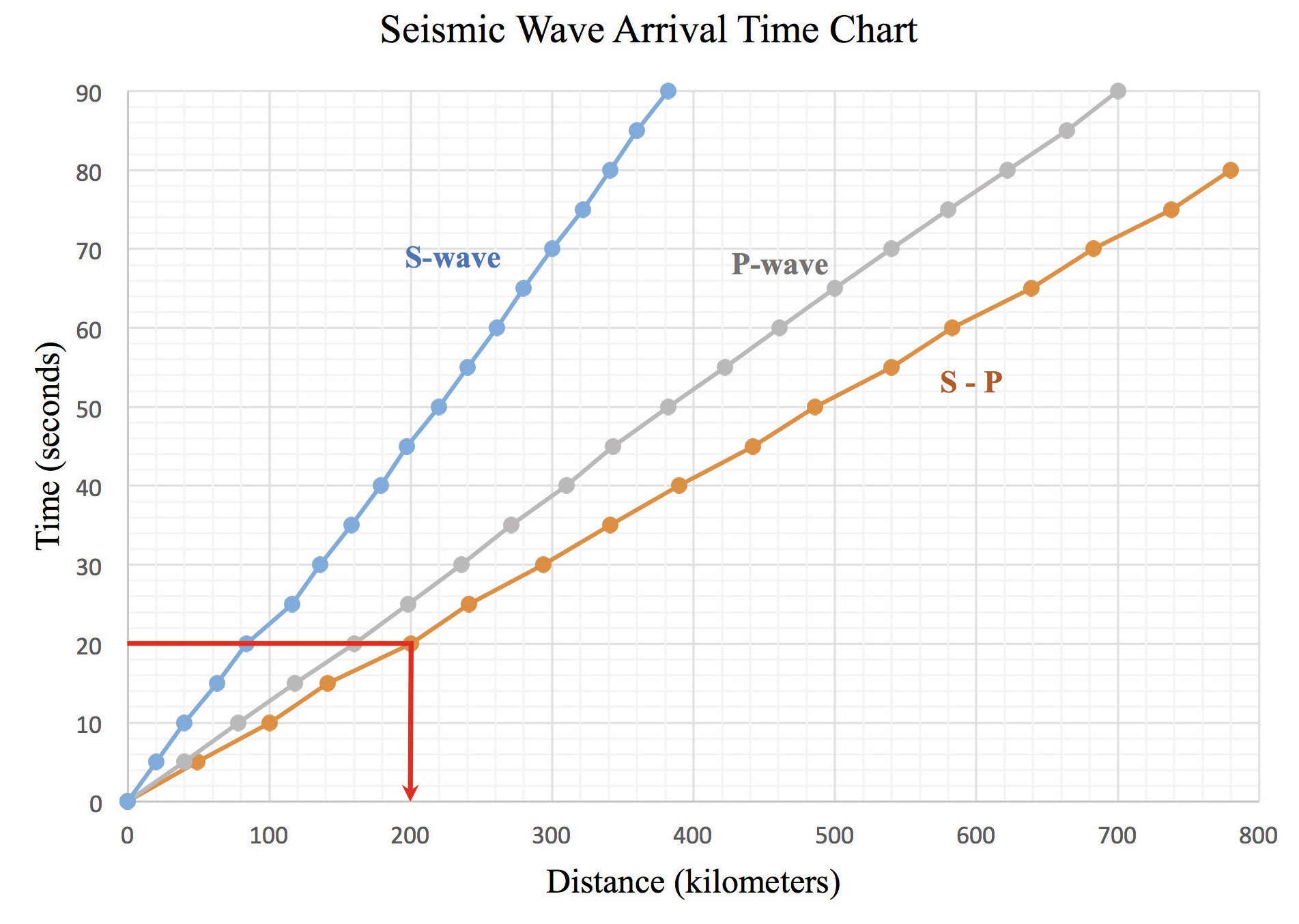
Source: Randa Harris (2015) CC BY-SA 3.0 view source
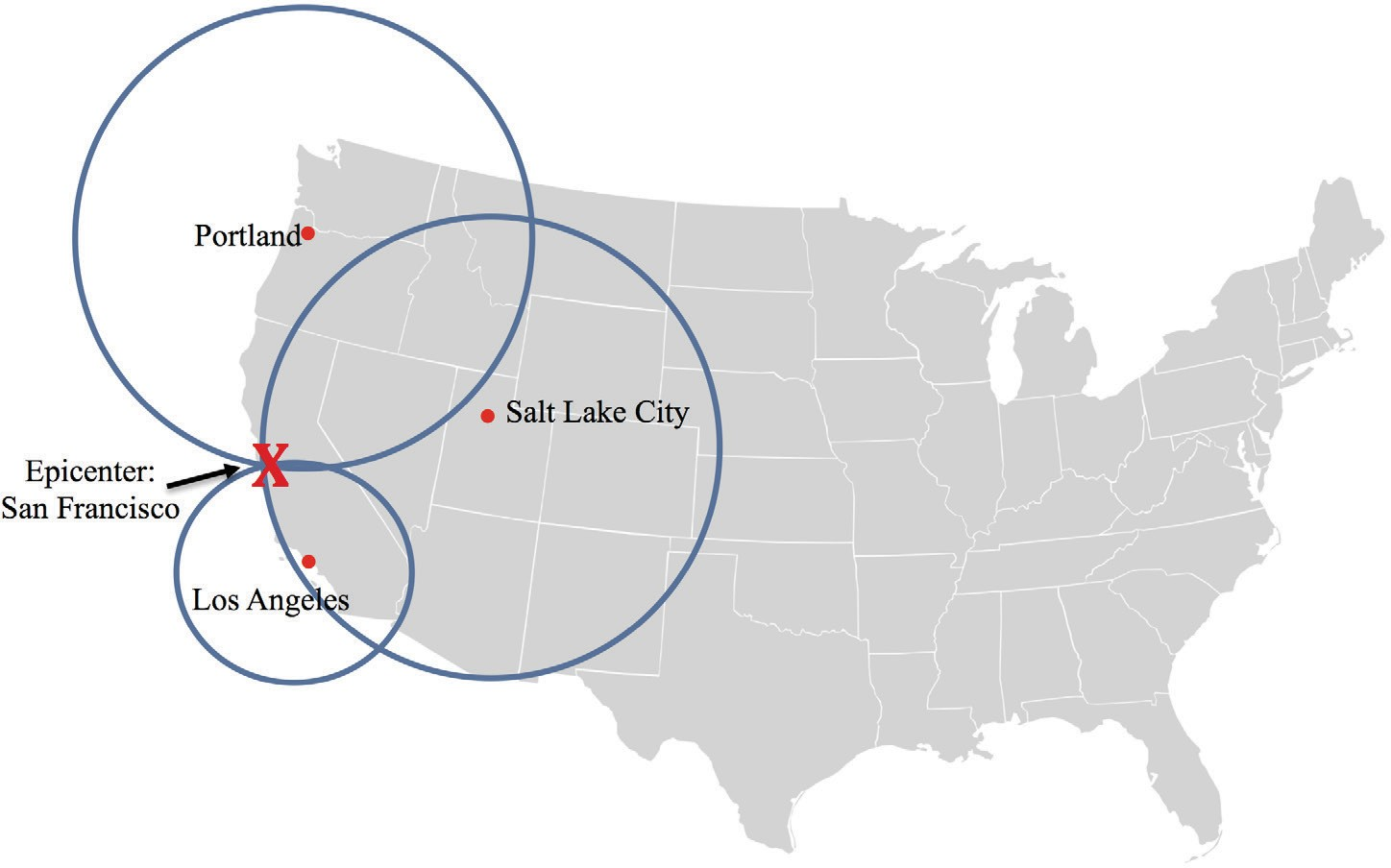
9.5 HAZARDS FROM EARTHQUAKES
Earthquakes are among nature’s most destructive phenomena, and there are numerous hazards associated with them. Ground shaking can lead to collapse of structures and falling debris; this is most dangerous hazard in urban areas and for people indoors at the time of an earthquake. The intensity of ground shaking depends on several factors, including the size of the earthquake, the duration of shaking, the distance from the epicentre, and the geology and material properties of the ground. Solid bedrock will not shake much during an earthquake, rendering it safer than other ground materials. Artificial fill refers to areas that have been filled in for construction and/or waste disposal (think of a hill that gets cleared for a shopping mall – the soil that was removed is dumped somewhere else as artificial fill). Sediment is not always well compacted in areas where people have filled in natural landscapes (e.g., in developments in coastal regions where developers have reclaimed marshes to build houses); compaction will occur during the shaking of an earthquake, and this can lead to structure collapse. Artificial fill sediments behave similarly to water-saturated sediments. As saturated sediments are shaken, they may experience liquefaction, a process where saturated sediments behave like a fluid. Normally, friction between grains prevents sediments from flowing. When an earthquake occurs, water surrounds every grain, eliminating the friction between the grains, and decreasing their strength and allowing them to flow (Figure 9.13). Liquifaction can be very destructive if there are buildings on top of these deposits when it occurs; they can sink into the ground. Another hazard associated with liquefaction is that seismic waves will amplify as they come in contact with the weaker saturated sediment materials, leading to even more damage.
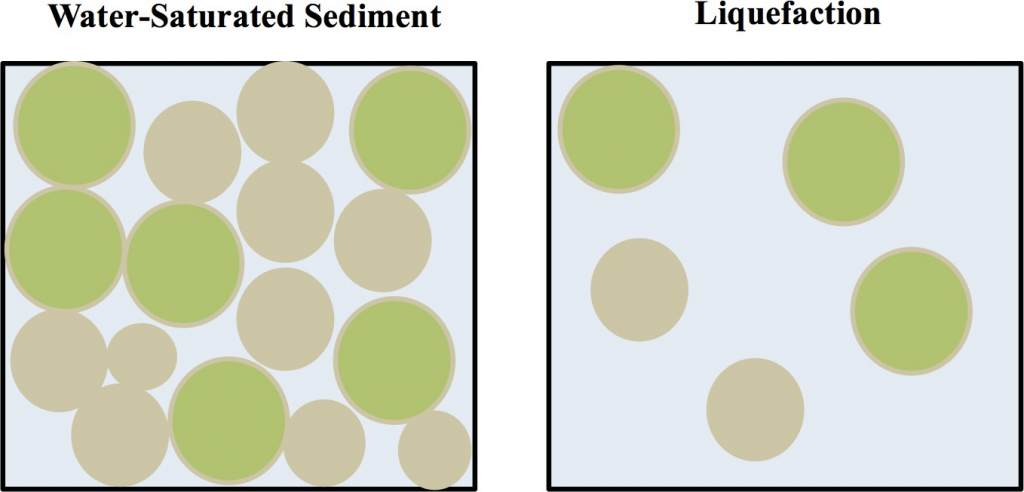
Source: Randa Harris (2015) CC BY-SA 3.0 view source
Another hazard associated with earthquakes is fires that can occur when gas lines rupture. These fires can be difficult to combat as water lines may also be ruptured and damage and debris may make it difficult for fire crews to reach the fire. The vast majority of damage during the 1906 San Francisco earthquake was due to fire. Earthquakes can also trigger tsunamis, large sea waves created by the displacement of a large volume of water vertically during fault movement under the ocean. The Sumatra-Andaman earthquake in 2004 triggered a tsunami in the Indian Ocean that resulted in approximately 230,000 deaths. Earthquakes can trigger landslides in mountainous areas, and initiate secondary hazards such as fires, dam breaks, and chemical spills.
Governments in earthquake-prone areas can take steps to minimize destruction, such as: implementing stronger building codes and retrofitting older buildings to strengthen them; educating the public to prepare for earthquake hazards; using the global tsunami warning system to prepare for tsunami events and evacuate citizens if necessary; addressing poverty and social vulnerability in earthquake-prone areas to decrease risk for affected citizens; and limiting development in hazardous zones.
9.6 INDUCED SEISMICITY
The number of notable earthquakes within the central and eastern United States has climbed sharply in recent years. During the thirty-six year period between 1973 and 2008, only 21 earthquakes with a magnitude of 3.0 or greater occurred. During the 5 year period of 2009-2013, 99 earthquakes of that size occurred within the same area, with 659 earthquakes in 2014 alone. There were well over 800 earthquakes in 2015 in Oklahoma (see the blue and red line on the graph in Figure 9.14).
Human intervention is apparently the cause of this increase in earthquake frequency. The term we used to describe this increase is induced seismicity (earthquakes caused by human activities). There has been much research into the potential causes for the recent induced seismicity; evidence points to several contributing factors, all related to types of fluid injection used by the oil industry. Hydraulic fracturing, also referred to as fracking, has been used for decades by oil and gas companies to improve well production. Fracking fluid contains water and additives (e.g., compounds to kill bacteria and decrease friction as the fluid is delivered into the reservoir rocks) as well as propping agents (e.g., sand) to hold fractures open in the reservoir rock. This fluid is injected at high pressure into low-permeability rocks in an effort to fracture the rock and increase the permeability. As more fractures open up within the rock, fluids such as oil or gas can move more easily through the reservoir rock, increasing well production.
With the recent advent of horizontal drilling technology, the fracking industry has increased dramatically since this technology offers opportunities to access previously inaccessible oil and gas resources. Drillers can now access thin horizontal oil and gas reservoirs over long distances, highly increasing well production in rocks that formerly were not exploited. While there have been many reports in the public that blame fracking for increased seismicity rates, this is not the whole story. Fracking mainly produces very minor earthquakes (less than magnitude 3), though it has been shown to produce significant earthquakes on occasion. The majority of induced earthquakes are caused by injection of wastewater deep underground. This wastewater is the byproduct of fracking, so ultimately the source of the induced seismicity is still primarily the oil and gas industry.
As wells are developed (made to produce more oil or gas) by fracking or other processes, large amounts of waste fluid are created. These fluids may contain potentially hazardous chemicals. When the fluids cannot be recycled or stored in retention ponds above ground, they are injected deep underground, to a depth that theoretically is deep enough to not come into contact with oil reservoirs or water supplies. These wastewater wells are quite common and are considered a safe option for wastewater disposal based on models for water flow in the subsurface. If water is injected in areas that contain faults, however, the stress conditions on the faults may change as the friction is reduced by the fluids. This can result in movement along faults and earthquakes.

Source: USGS (2016) Public Domain view source
In the lab exercises for this chapter, we will explore data from induced seismicity in the state of Oklahoma. Figure 9.14 shows the distribution of earthquakes through the central USA between 1973 and 2015. Note the high density of red spots in the centre of the map, these are earthquakes in the years 2009-2015 and are mostly in the state of Oklahoma (Figure 9.15). Research by the USGS has determined that source of this seismic hazard is the disposal of wastewater from the oil and gas industry by deep injection, though some smaller quakes (magnitude 0.6 to 2.9) have been shown to correlate directly to fracking. A 50% increase in earthquake rate has occurred within Oklahoma since 2013. One large earthquake of 5.7 magnitude struck in November, 2011, and has been linked to an active wastewater injection site about 200 meters away.

Source: USGS Public Domain view source

